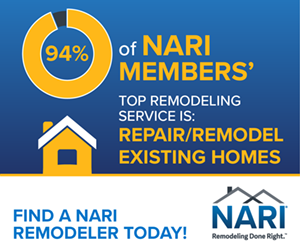Top 10 Steps to Prepare for Remodel
Plan for Success
 Research your project
Research your project
Taking time to research projects on the Internet and NARI.org will provide a good sense of what is involved such as price, scope of work, return on investment and new product/material options. Also, research property values in your neighborhood to make sure your project is in line with other homes in the area.
Plan project around the long-term
How long do you plan to stay in your home? How might your family structure change over time? Life can change quickly—these questions should be answered early on to ensure your project will fit your lifestyle long after it’s complete.
Set your budget
Deciding on a realistic budget and arranging finances to support your project are essential. This number needs to include everything—the project, products, contingencies, etc. Don’t be afraid to share this with your remodeler; professionals are respectful of a client’s budget and will create a plan around it, not over it.
Use advanced search for professionals
The online world makes it easy to gather information about strangers. Ask friends, family and neighbors for referrals and then spend time researching that person online. Professional remodelers take their reputation seriously and hold credentials beyond licensing, such as certifications, memberships in trade associations and additional training. Look for examples of press coverage or involvement in industry presentations or events. Check online reviews and social media to see how they interact with past clients and peers.
Ask the right questions
Time and cost are important, but getting the right information requires the right questions. Ask your professional remodeler about his educational background, training, specialties or past issues with clients. Ask about how the remodeling process will work.
Verify your remodeler
Don’t take their word for it. Check the information given to you such as references, license numbers, insurance information and certifications by calling providers to verify. Request a visit to an active client’s jobsite. Make it known that you are checking on him—a true professional considers that as a positive sign to working with a homeowner.
Review contracts word-by-word
A remodeling contract protects you and your remodeler. Homeowners should review this carefully. Professional remodelers have done this before, and know what should go in a contract. Homeowners are not as familiar with remodeling and should ask about terms if they don’t understand. Pay attention to details about change orders, payment, additional fees, timeline and responsibilities. If it’s not in the contract, it doesn’t exist.
Keep design in mind
Your design guides the entire project. Think about what you dislike about your current space and the intended use of the new space. Use Websites such as Pinterest.com and Houzz.com to gather design ideas. Make sure you can articulate specifically what you like about that design when talking to your designer. Professionals don’t recreate a photo—they incorporate accessibility, functionality, ease of modification, style and value into your design.
Make your selections
Deciding on products and materials is a larger process than most imagine. With so many options to choose from, product selections are one of the primary reasons for project timelines to get extended. Base decisions on quality, function, price, style and availability. Include selections in the contract to lock down pricing and keep your budget intact.
Create a communication plan
A common downfall in remodeling is lack of communication between homeowners and remodelers. Your remodeler should lay out a communication plan at the beginning of the project. If not, ask them to do so. This plan should clarify roles of everyone involved, communication methods, availability, and frequency of communication that is expected.
